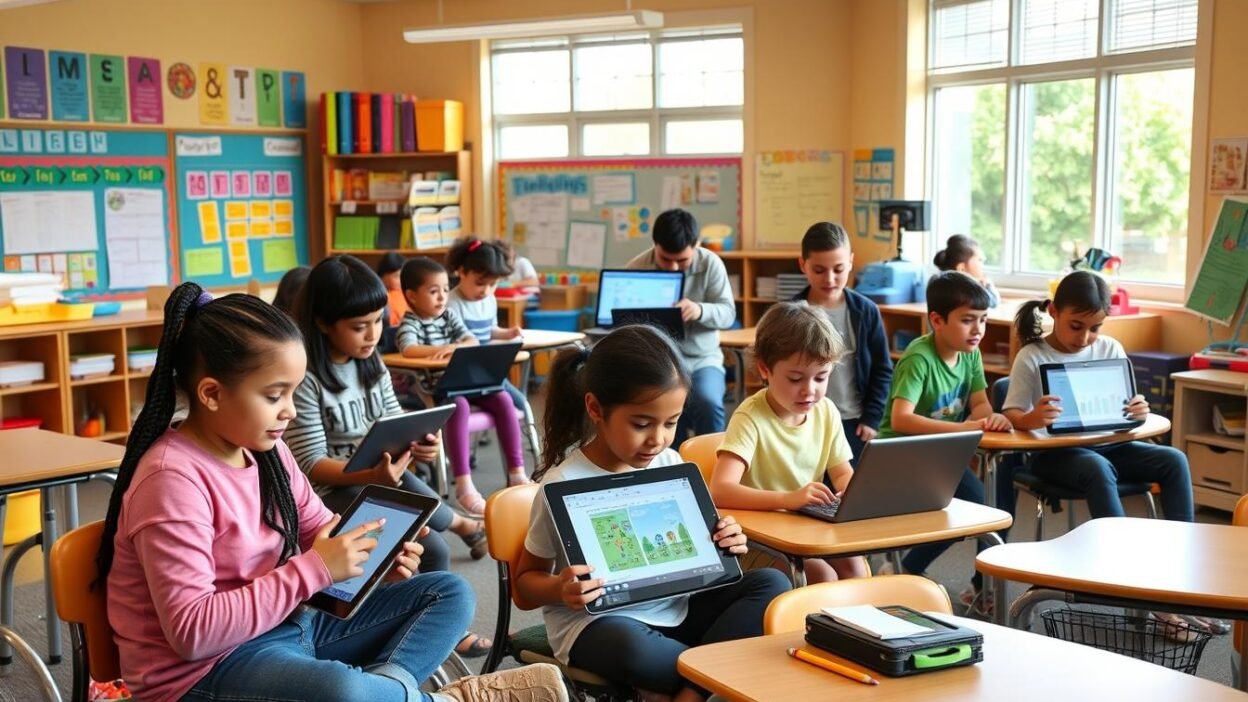Technology is revolutionizing education for all students. It’s challenging us to rethink learning for every child. In India, assistive technology is transforming inclusive education and boosting student success.
Assistive technology unlocks potential for learners of all abilities. It creates spaces where every student can flourish. These tools adapt resources to meet unique needs, making learning more equitable.
Text-to-speech software and specialized input devices are game-changers. They’re reshaping education, ensuring no learner falls behind. Assistive technology is leveling the playing field in classrooms.
These tools support students with disabilities and enhance learning for all. They foster inclusivity and boost academic achievement. Innovative approaches to education are elevating student success across the board.
Preparing for the UGC NET exam can be a daunting task, but with the right resources, candidates can navigate the process effectively. Websites like MyJRF provide a comprehensive platform for aspiring educators, offering specialized guidance for UGC NET Paper 2 preparation and essential tips for acing UGC NET Paper 1. Additionally, understanding the revised syllabus provided by UGC is crucial for a targeted study approach. For official announcements and updates, candidates should regularly visit the UGC NET NTA portal, while the UGC’s job section and the main UGC website are invaluable for post-exam opportunities and academic resources. With these tools, candidates can maximize their preparation and set themselves up for success.
Key Takeaways
- Assistive technology creates equal learning opportunities for all students
- Adaptive educational resources cater to diverse student needs
- Inclusive classrooms benefit from a wide range of assistive tools
- Technology enhances overall student success and engagement
- Implementing assistive technology fosters a more inclusive learning environment
Introduction to Inclusive Education
Inclusive education is the foundation of modern learning systems. It creates programs for all students, regardless of abilities or backgrounds. This approach has changed how we view learning in schools today.
Over time, inclusive education has shaped skill development methods. It aims to meet the needs of every student in the classroom.
Definition and Importance
Inclusive education welcomes all learners into regular classrooms. It values diversity and supports each student’s unique needs. This method builds a stronger society by teaching respect for differences.
Historical Context
The push for inclusive education started in the mid-20th century. Parents and activists fought for children with disabilities to learn with peers. This led to laws that changed how schools approach learning.
The Role of Inclusivity in Modern Education
Inclusive education creates fair learning spaces. It supports skill development and prepares students for life after school. Many schools use special tools to help every student succeed.
| Benefits of Inclusive Education | Challenges |
|---|---|
| Improved social skills | Need for teacher training |
| Better academic outcomes | Adapting curriculum |
| Increased empathy | Resource allocation |
Inclusive education will shape future learning experiences. It creates classrooms where every student can thrive. This approach helps all learners reach their full potential.
Understanding Assistive Technology
Assistive technology enhances learning for students with diverse needs. It bridges gaps and creates inclusive environments. This innovative approach transforms educational resources.
What is Assistive Technology?
Assistive technology includes tools, devices, and software for students with disabilities. It improves access to educational content and promotes independent learning.
These technologies adapt to various learning styles and abilities. They range from simple reading aids to complex computer systems.
Types of Assistive Technologies
Assistive technologies address specific learning needs in various forms:
- Text-to-speech software for reading support
- Speech recognition tools for writing assistance
- Alternative input devices for physical disabilities
- Visual aids for students with vision impairments
- Hearing assistive technologies for audio enhancement
These tools make distance learning more accessible and inclusive. They help create personalized learning experiences for each student.
Educators can cater to unique requirements by integrating assistive technology into classrooms.
“Assistive technology is not just about providing tools; it’s about opening doors to education for all learners.”
Assistive technology remains crucial in inclusive learning strategies. It empowers students to overcome barriers in all learning settings.
Students can achieve their full potential with these tools. This applies to both traditional and distance learning environments.
Benefits of Assistive Technology in Classrooms
Assistive technology has changed education for the better. It helps students with different learning needs. These tools make learning easier and more fun for everyone.
Enhancing Learning Opportunities
Assistive technology opens up new ways to learn. Text-to-speech software helps students who struggle with reading. Digital whiteboards make visual learning more interactive.
These tools give all students a fair chance. Everyone can join in class activities fully.
| Learning Area | Assistive Technology | Impact on Student Success |
|---|---|---|
| Reading | Text-to-speech software | 20% improvement in comprehension |
| Writing | Speech-to-text tools | 30% increase in writing output |
| Math | Digital manipulatives | 25% better problem-solving skills |
Fostering Independence in Students
Assistive technology helps students take charge of their learning. Screen readers let visually impaired students use digital content on their own. Organizational apps help students with ADHD manage their work.
This independence builds confidence. It also prepares students for future challenges in school and work.
“Assistive technology transformed my classroom. Students who once struggled now thrive, showing remarkable progress in their studies and self-reliance,” says Ms. Patel, a special education teacher in Mumbai.
Assistive technology creates a classroom where all students can succeed. These tools support learning and build important life skills. They set students up for long-term success.
Key Features of Effective Assistive Technology
Assistive technology boosts education and learning experiences. These tools support skill development for students with diverse needs. They provide valuable educational resources to enhance learning.
User-Friendly Design
User-friendly design is vital for effective assistive technology. Intuitive interfaces help students use tools easily. This promotes independence and confidence in their learning journey.
- Simple navigation menus
- Clear, concise instructions
- Customizable settings for individual preferences
- Consistent layout across different features
Compatibility with Learning Goals
Assistive technology must align with educational objectives. This ensures students can use tools to reach their learning goals. It also helps them access the curriculum effectively.
| Learning Goal | Compatible Assistive Technology |
|---|---|
| Reading comprehension | Text-to-speech software |
| Writing skills | Word prediction tools |
| Math problem-solving | Digital graphing calculators |
| Communication | Speech-generating devices |
User-friendly design and learning goal compatibility are crucial for assistive technology. These features enhance education for all students. They create inclusive and effective learning environments.
Implementing Assistive Technology: Strategies for Educators
Educators are key in using assistive technology to boost learning. This section looks at ways to blend these tools into academic programs and study tips.
Assessing Student Needs
Finding each student’s needs is crucial for success. Teachers should do full checks to pick the best assistive tech for each learner.
- Observe students’ learning patterns
- Consult with specialists and families
- Review academic performance data
- Conduct assistive technology trials
Integrating Technology into Lesson Plans
After finding needs, teachers can add assistive tools to their lessons. This makes learning better and more inclusive for all students.
| Technology | Integration Strategy | Learning Benefit |
|---|---|---|
| Text-to-speech software | Use for reading assignments | Improves comprehension |
| Speech recognition tools | Implement for writing tasks | Enhances written expression |
| Visual aids | Incorporate in presentations | Supports visual learners |
Smart use of assistive tech creates a more inclusive learning space. This helps students with different needs. It also makes learning better for everyone.
Case Studies: Successful Implementation Examples
Schools in India are using assistive technology to improve education. This approach helps all students succeed. Let’s look at some schools leading the way in inclusive learning.
Schools Leading the Way
The Delhi Public School in Bangalore uses text-to-speech software in class. This tool helps students with reading issues access materials more easily.
At Vidyasagar School in Chennai, students use special keyboards and switches. These devices help them work with computers and engage more in their studies.
Impact on Student Outcomes
Assistive technology has shown great results in student learning. A study of 50 Mumbai schools found big improvements in grades and student confidence.
| Metric | Before AT Implementation | After AT Implementation |
|---|---|---|
| Average Test Scores | 65% | 78% |
| Class Participation | 40% | 75% |
| Homework Completion Rate | 60% | 85% |
These results show how assistive technology improves education. Schools are creating spaces where all students can thrive. This support helps every student achieve academic success.
Challenges in Using Assistive Technology
Schools face hurdles when integrating assistive technology in education. Financial limitations and training needs impact their ability to create inclusive learning spaces. These challenges affect the effectiveness of assistive tools in classrooms.
Financial Constraints
Budget restrictions often limit assistive technology adoption in classrooms. Schools struggle to purchase and maintain these tools for diverse learners. The cost of specialized devices and software can strain resources, especially in underfunded districts.
Training and Support Issues
Effective use of assistive technology requires proper training for educators. Many teachers lack skills to integrate these tools into lessons. This knowledge gap can hinder the full potential of assistive devices in learning.
| Challenge | Impact on Education | Potential Solutions |
|---|---|---|
| Limited Funding | Reduced access to assistive tools | Grants, partnerships with tech companies |
| Lack of Training | Underutilization of available resources | Professional development programs, online courses |
| Technical Support | Disruptions in learning due to device issues | On-site IT staff, remote troubleshooting services |
Addressing these issues requires a multi-faceted approach. Schools must find creative funding options and invest in training programs. Establishing robust support systems is crucial for success.
By tackling these challenges, schools can unlock the power of assistive technology. This effort creates inclusive and effective learning environments for all students.
Building a Supportive Environment
A supportive environment is vital for successful education with assistive technology. It promotes student success through collaboration and acceptance. This approach helps develop essential skills for learners.
Collaboration Between Educators and Families
Strong partnerships between teachers and parents are crucial for effective learning. Regular meetings and shared goals align educational strategies at school and home. Open communication ensures consistent support for students using assistive technologies.
- Monthly progress updates
- At-home technology training for families
- Joint goal-setting sessions
Creating a Culture of Acceptance
An inclusive atmosphere is essential for student success. Schools can promote acceptance by educating all students about diverse learning needs. This builds empathy and creates a more supportive learning environment.
Understanding the benefits of assistive technologies helps foster a culture of acceptance. This knowledge encourages students to support their peers who use these tools.
Strategies to build an accepting culture include:
- Peer mentoring programs
- Inclusive classroom activities
- School-wide awareness campaigns
| Strategy | Benefits |
|---|---|
| Collaborative meetings | Aligned educational goals |
| Technology workshops | Enhanced family support |
| Inclusive activities | Increased peer understanding |
Schools that focus on collaboration and acceptance create a thriving environment. This approach benefits all students, regardless of their learning needs. It supports those who use assistive technologies to reach their full potential.
Future Trends in Assistive Technology
Education is changing fast with new technologies shaping how we learn. Assistive technology leads this change, making inclusive education and online courses better.
Advances in AI and Machine Learning
AI and Machine Learning will transform assistive technology in education. They can analyze student data to create personalized learning paths. These tools adapt to individual needs and learning styles.
AI-powered chatbots offer 24/7 support in distance learning. They answer questions and provide guidance. Machine learning can predict student performance, helping educators provide targeted support early.
This predictive ability improves online courses and traditional classrooms. It helps teachers understand student needs better.
The Role of Virtual Reality
Virtual Reality (VR) creates new opportunities in education, especially for students with disabilities. VR offers immersive learning experiences. Students can explore historical sites, conduct virtual experiments, or practice social skills safely.
| VR Application | Educational Benefit |
|---|---|
| Virtual Field Trips | Enhances geography and history learning |
| 3D Modeling | Improves spatial understanding in STEM subjects |
| Social Scenarios | Develops communication skills for special needs students |
These technologies make education more accessible and engaging for all learners. They work well for students with different abilities. The future of assistive technology in education looks promising.
Policies Supporting Assistive Technology in Education
Education policies promote assistive technology use in classrooms. They ensure all students can access educational resources. These policies support students of all abilities in academic programs.
Federal Legislation Overview
The Individuals with Disabilities Education Act (IDEA) supports assistive technology in schools. It requires schools to provide assistive devices for students with disabilities. These tools help students access their education effectively.
Other key federal laws include Section 504, the ADA, and ESSA. Together, they ensure equal learning opportunities for all students.
State-level Initiatives
Many states have launched initiatives for inclusive education through technology. These programs focus on teacher training and assistive device grants. Some states partner with technology companies to improve access.
California’s Assistive Technology Network is an example. It provides resources and support to educators statewide.
| Policy Level | Key Legislation | Impact on Education |
|---|---|---|
| Federal | IDEA, ADA, ESSA | Mandates assistive technology provision |
| State | Varies by state | Provides funding and training programs |
| Local | School district policies | Implements federal and state requirements |
These policies create a framework for using assistive technology in schools. They foster inclusive learning environments for all students. This approach helps meet diverse educational needs effectively.
Conclusion: A Vision for Inclusive Classrooms
Assistive technology is a powerful tool for creating inclusive learning environments. It unlocks new possibilities for student success across diverse learning needs. Educators can use these innovative solutions to help all students thrive.
The Path Ahead for Educators and Learners
Inclusive classrooms require ongoing commitment from educators, policymakers, and technology developers. Assistive technologies will play a vital role in breaking down learning barriers. This progress will make education more accessible and engaging for all students.
Encouraging Lifelong Learning
Assistive technology supports immediate educational goals and fosters lifelong learning. It empowers students with tools that adapt to their unique needs. These tools build independence and confidence, essential skills for success beyond the classroom.
Embracing assistive technology brings us closer to an inclusive educational landscape. This vision celebrates diversity and harnesses the power of innovation. It opens doors to limitless opportunities for growth and achievement.
FAQ
What is assistive technology in education?
Assistive technology in education helps students with disabilities or diverse learning needs. It includes devices, software, or equipment that enhance learning opportunities. These tools range from simple pencil grips to complex speech-to-text software.
How does assistive technology promote inclusive education?
Assistive technology levels the playing field for students with diverse needs. It allows for personalized learning experiences and enables access to curriculum content. This technology helps remove barriers to participation in classroom activities.
What are some common types of assistive technologies used in classrooms?
Common assistive technologies include screen readers, text-to-speech software, and alternative keyboards. Voice recognition programs, visual aids, and hearing assistive devices are also used. The specific technology depends on individual student needs and learning objectives.
How can educators effectively implement assistive technology in their classrooms?
Educators should first assess individual student needs. Then, they can select tools that align with learning goals. It’s important to integrate technology into lesson plans seamlessly.
Providing adequate training for students and staff is crucial. Regular evaluation of the tools’ effectiveness in supporting student success is also necessary.
What are the main challenges in implementing assistive technology in schools?
Financial constraints can be a challenge, as some assistive technologies are expensive. Providing adequate training and ongoing support for educators and students is also difficult.
Ensuring compatibility with existing school systems can be problematic. Overcoming resistance to change is another hurdle schools may face.
How does assistive technology impact student outcomes?
Assistive technology can significantly improve student engagement and independence. It allows students with diverse needs to participate more fully in classroom activities. This boost in confidence fosters a more positive attitude towards learning.
What role do policies play in supporting assistive technology in education?
Policies mandate the availability and use of assistive technology in educational settings. Federal legislation like IDEA requires schools to consider assistive technology for students with disabilities. State-level initiatives often provide funding and implementation guidelines.
What are some emerging trends in assistive technology for education?
Artificial intelligence and machine learning are creating more personalized learning experiences. Virtual and augmented reality technologies are being explored for immersive learning environments. There’s also a growing focus on developing more intuitive interfaces for assistive tools.
How can schools create a supportive environment for assistive technology use?
Schools can foster collaboration between educators, families, and students. They should provide comprehensive training programs and encourage open communication about technology needs. Cultivating a school culture that embraces diversity and technological innovation is crucial.
What is the future outlook for assistive technology in inclusive classrooms?
The future of assistive technology in inclusive classrooms looks promising. Advancements in personalized learning tools and AI-driven assistive devices are expected. More seamless integration of technology into curriculum design is also anticipated.





